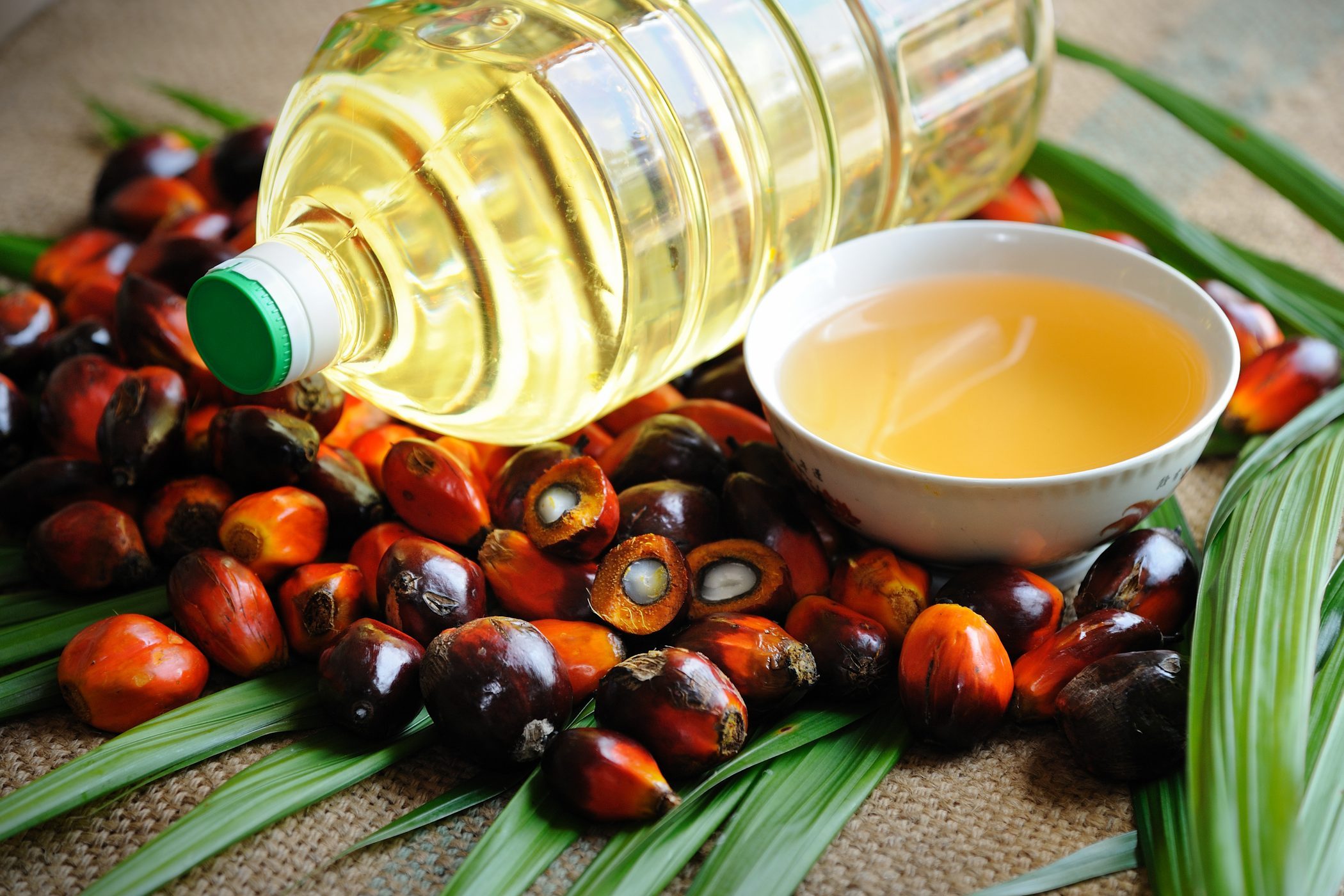Is Palm Oil Bad for You? What You Need to Know
Updated: Mar. 17, 2022
Palm oil is the most widely produced vegetable oil in the world. Learn more about its nutrition, calorie content, and whether it's good or bad for your health and the environment.
Is palm oil good for you?
Palm oil is used all over the world to cook a wide range of foods. People have claimed it can protect your brain, speed your metabolism, help you lose weight, and fight cancer, aging, and malaria. So it must be good for you, right?
Not so fast. Palm oil may not be as good—or as bad—as you think. (Learn more about healthy cooking oils.)
Palm oil primarily comes from the tropics
Palm oil comes from the fruit of the palm tree, which is prolific in tropical regions of the world. It’s easy to confuse with palm kernel oil, but they’re not the same thing. Palm kernel oil is made from the seed, or kernel, of the palm tree.
Palm oil is used widely, especially in the developing world, to prepare and fry food. But you can find it in products as diverse as pizza and lipstick.
It’s a versatile fat, says Kristen Smith, RD, a spokesperson for the Academy of Nutrition and Dietetics in Minneapolis. It can come in the form of liquid cooking oil, but at room temperature, it’s semisolid, meaning you can also spread it like margarine.
(Here’s what to know about the smoke point of cooking oils.)
Palm oil is in a lot of products
Palm oil is the most common vegetable oil in the world, according to the Bulletin of the World Health Organization. In the developing world, the oil is used for preparing and cooking food, especially fried foods.
Few people in the United States use the oil for home cooking, says Smith. Instead, it’s abundant in processed foods like doughnuts, pizza, margarine, chocolate, margarine, and bread.
It’s even present in some inedible products you probably use, including lipstick, detergent, shampoo, and soap.
Palm oil nutrition facts
This is the nutritional profile of one tablespoon (13.6 grams) of palm oil, plus the percent of your daily recommended value (DV) it contains for certain nutrients:
Calories: 120
Fat: 13.6 (21 percent DV)
Saturated fat: 6.6 g (33 percent DV)
Polyunsaturated fat: 1.3 g
Vitamin E: 2.2 mg

The nature of fats
How a fat appears at room temperature offers a hint at its health qualities. This has to do with the type of fat molecule—saturated or unsaturated—in the product.
In general, the more saturated fat an oil contains, the more likely it is to be solid at room temperature. The opposite is true of unsaturated fats: Oils higher in unsaturated fats, which tend to be better for your health than saturated fats, are liquid at room temperature.
Unhealthy fats
In the hierarchy of dietary fats, trans fats are considered to be the most harmful to your health. They were used in food much more often in the past, for example, in margarine, fried foods, and baked goods.
Trans fats raise blood levels of “bad” low-density lipoprotein (LDL) cholesterol and triglycerides while lowering “good” high-density lipoprotein (HDL) cholesterol, all of which can contribute to heart attacks and strokes.
They’re so harmful to your health, in fact, that the Food and Drug Administration banned trans fats in 2015, giving manufacturers three years to phase them out.
Saturated fats can also be problematic in terms of your heart health. Meat, dairy, and coconut oil have higher levels of saturated fat.
“Consuming high amounts of saturated fat can worsen your lipoprotein profile, such as the level of bad cholesterol (LDL) in your blood, [which] may increase cardiovascular disease risk,” says Greg Henderson, PhD, assistant professor of nutrition science at Purdue University in West Lafayette, Indiana. “It can also potentially lead to increased inflammation, a process linked to various disease states.”
The bottom line? Although not all saturated fats are created equal, it’s a good idea to keep your saturated fat intake low. (Here are the packaged foods with hidden saturated fats.)
Healthier fats
Unsaturated fats (both monounsaturated and polyunsaturated) are considered the healthiest fats of them all, says Henderson. These fats can lower your risk of heart disease and improve cholesterol and triglyceride levels.
Sources of “good” fat include nuts, vegetable oils, peanut butter, avocado, salmon and other fatty fish, flaxseeds, and chia seeds.
One caveat: “It’s important to remember that even though fats are labeled as good or heart-healthy, they still offer calories,” says Smith. “They can add up in calories, which can lead to weight gain.”
(Here’s what you need to know about olive oil and cholesterol.)
Palm oil is a saturated fat—sort of
With trans fats off limits, the food industry looked for other compounds as substitutes. One of them was palm oil.
That doesn’t mean palm oil is anywhere near as bad as trans fat, but it’s also not as good as unsaturated fats like olive oil, canola oil, and other vegetable oils. (Canola oil vs vegetable oil: Which is healthier?)
The scientific jury is still out. One 2018 meta-analysis of palm oil research, which was published in the journal PLOS One, found there wasn’t enough evidence to pronounce palm oil either beneficial or harmful to heart health.
“Palm oil is high in saturated fat, though typically not quite as saturated as various animal products, such as butter,” says Henderson.
It’s about 50 percent saturated, which is better than both palm kernel oil and coconut oil, both of which are about 85 percent saturated fat.
Consume palm oil in moderation
A little palm oil isn’t likely to hurt you, but use it in moderation. A 2019 review in the journal Nutrition stated that consuming moderate amounts of palm oil wasn’t likely to pose any health risks.
Smith isn’t enthusiastic about its use. “I wouldn’t recommend running out and starting to add it to foods,” she says.
If you’re going to try palm oil, don’t use it to replace unsaturated fats in your diet.
“Consuming some palm oil and other oils with high saturated fat content should be acceptable if you also consume a significant amount of the oils that are considered to be potentially more healthy, such as those with higher amounts of monounsaturated fat and omega-3 polyunsaturated fat,” says Henderson. “By simultaneously consuming a reasonable amount of more highly unsaturated fats, one can essentially dilute out the saturated fat from palm oil to the point that it makes up only a modest proportion of the total fat and total calorie intake.”
A 2018 study in Nutrición Hospitalaria concurs: The cardiovascular risk associated with palm oil depends largely on which other fats you eat with it.
Read product labels
In an effort to reduce the percentage of your daily fat that comes from saturated fat, check the nutrition label. Focus on a product’s total fat.
“You don’t want saturated fat to be the largest percentage. If it’s the bulk of the fat type, then that’s something you want to use in moderation and not on a regular basis,” says Smith. “The American Heart Association recommends limiting saturated fat to less than 6 percent of total calories.” (Learn the secrets hidden in the nutrition label.)
Environmental concerns with palm oil
There’s another problem with palm oil, which is indirectly related to the whole world’s health. Palm tree plantations have overrun Africa, Asia, and Latin America.
Converting tropical forests into palm tree plantations has led to significant deforestation which, in turn, has led to a movement for sustainable palm oil production.
The World Wildlife Foundation has an online Scorecard so you can check which manufacturers and retailers are committed to sustainable palm oil agriculture.
You can also make sure it’s Roundtable on Sustainable Palm Oil (RSPO) certified. This organization is committed to making sure palm oil production is done sustainably, with respect to the environment and its inhabitants—wildlife and indigenous people.
The bottom line
Palm oil is a popular oil used worldwide in everything from cooking to the development of beauty products. When it comes to your health, it’s fine to use palm oil in moderation. That said, this oil isn’t as healthy as oils with unsaturated fats and shouldn’t be your go-to cooking oil.
And keep in mind that its production comes with environmental concerns regarding wildlife and indigenous people. Choosing brands that are committed to sustainable palm oil production is key.






















